#automatic control valve
Explore tagged Tumblr posts
Text
How WaterCop's Leak Detection Systems Enhance Commercial Safety
Introduction
Water damage is one of the most costly and disruptive issues for commercial properties. Whether it's a burst pipe, leaking appliance, or undetected plumbing failure, the consequences can lead to extensive repairs, operational downtime, and financial loss. WaterCop's leak detection systems offer a proactive solution, ensuring that businesses can detect and stop leaks before they escalate into major disasters.
Why Commercial Leak Detection Is Essential
For business owners, a commercial leak detection system is not just an added feature but a necessity. Early leak detection helps prevent:
Structural damage to buildings
Mold growth and health hazards
Equipment and inventory losses
Increased water bills due to unnoticed leaks
Business interruptions and costly repairs
How WaterCop’s Leak Detection Systems Work
WaterCop specializes in automatic water leak stop technology, utilizing advanced sensors and shut-off valves to detect and stop leaks instantly. These systems integrate seamlessly with water heater automatic shut-off valves, ensuring complete protection against unexpected failures.
Key Features of WaterCop’s Leak Detection Systems
Automatic Shut-Off Mechanism
Once a leak is detected, the system automatically shuts off the main water supply, preventing further damage.
Real-Time Alerts and Monitoring
Business owners receive instant notifications via smart technology, allowing quick action.
Integration with Water Heaters
A water heater automatic shut-off valve helps prevent catastrophic failures that could lead to flooding.
Commercial-Grade Reliability
Designed to handle high-demand environments, WaterCop’s systems ensure long-term efficiency and reliability.
Industries That Benefit from WaterCop’s Leak Detection Systems
Hospitality & Hotels
Prevents leaks in guest rooms, kitchens, and laundry facilities.
Reduces insurance claims and maintenance costs.
Healthcare Facilities
Protects critical medical equipment and patient areas from water damage.
Ensures compliance with safety and health regulations.
Retail & Shopping Centers
Prevents water damage to merchandise and inventory.
Avoids costly store closures and disruptions.
Office Buildings
Detects hidden leaks in large plumbing networks.
Protects IT infrastructure and office equipment.
Industrial & Manufacturing
Prevents equipment failure due to water damage.
Reduces downtime and production loss.
Frequently Asked Questions (FAQs)
1. How does WaterCop’s leak detection system prevent water damage?
WaterCop’s system detects leaks through strategically placed sensors and automatically shuts off the water supply to prevent further damage.
2. Can WaterCop be integrated with a water heater?
Yes, WaterCop offers a water heater automatic shut-off valve, ensuring that leaks from water heaters are detected and stopped before they cause flooding.
3. Is WaterCop suitable for large commercial properties?
Absolutely. WaterCop’s scalable solutions are designed for small businesses, large facilities, and multi-story buildings.
4. How difficult is the installation process?
WaterCop systems are designed for easy installation and can be integrated into existing plumbing systems with minimal modifications.
Conclusion
For businesses seeking to stop water leaks stop before they cause significant damage, WaterCop’s leak detection systems offer an intelligent, automated solution. Whether you need protection for a commercial property, water heater, or high-value equipment, WaterCop provides peace of mind with its reliable and efficient leak prevention technology.
Protect Your Business with WaterCop Today!
Invest in a WaterCop water leak stop solution to safeguard your commercial property from costly water damage. Contact us today to find the right system for your needs!
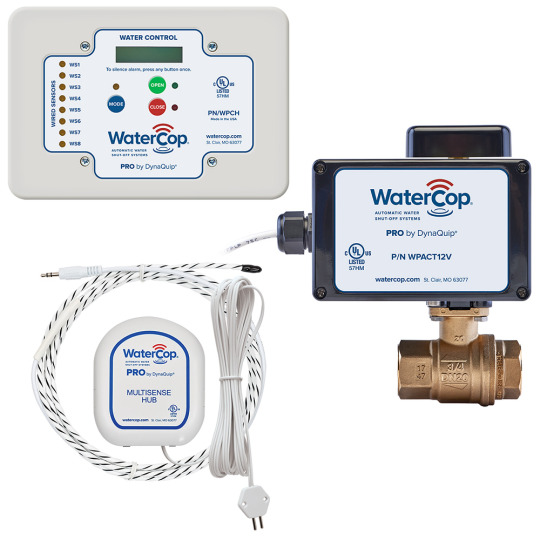
#WaterLeakStop#CommercialLeakPrevention#WaterCop#WaterDamageProtection#PlumbingSafety#AutomaticShutOffValve#SmartWaterControl#WaterHeaterSafety#BusinessContinuity#IndustrialLeakDetection#FacilityManagement#WaterWasteReduction#OfficeBuildingSecurity#ManufacturingProtection#CostEffectiveSafety#LeakDetectionSystems#water leak detectors residential#water leak detection#water heater automatic shut off valve#automatic water valve control#water sensing shut off valve#commercial leak detection#water sensor shut off valve#water pipe automatic valve#residential water leak detectors#wifi water shut off valve
0 notes
Text
FloControl Ltd
FloControl offers a comprehensive range of valves, pipeline products, and highly engineered pre-assembled system solutions for fluid handling applications within the UK building services industry. We provide the most innovative PICVs, ABVs, DPCVs, pre-assembled Valve Set arrangements, and Manifolds plus a full range of ancillary products, sourced from world-class manufacturers. Our products and solutions provide superior environmental comfort whilst reducing the capital, installation, commissioning, and running cost of heating and cooling systems as well as reducing a building’s carbon footprint.
#Automatic Balancing Valve#Automatic Balancing Valves#Balancing Valve#Dynamic Balancing Valve#Energy Valve#Energy Control Valves
0 notes
Text
Self-closing valve with Prabha Electronics
In industrial settings, maintaining control over fluid and gas flow is crucial for both safety and efficiency. The Self-Closing Valve by Prabha Electronics offers an innovative solution to address these needs, providing automatic shut-off functionality that enhances operational reliability and safety.
What is a Self-Closing Valve?
A Self-Closing Valve is a specialized device designed to automatically seal itself when the flow of fluid or gas stops. This mechanism is particularly valuable in preventing leaks and reducing the need for manual intervention. Ensuring that the valve closes without human input, not only simplifies operation but also enhances overall safety by minimizing the risk of accidental leakage.

Key Benefits of Self-Closing Valves
Automatic Operation: One of the standout features of Self-Closing Valves is their automatic closure capability. This means that once the fluid or gas flow is interrupted, the valve seals itself without requiring manual adjustments. This automatic function is particularly beneficial in high-pressure environments where manual operation may be impractical.
Leak Prevention: By closing automatically when not in use, these valves significantly reduce the likelihood of leaks. This is essential for maintaining the integrity of systems and preventing potential hazards associated with fluid or gas leakage.
Durability and Reliability: Prabha Electronics’ Self-Closing Valves are built to withstand harsh conditions and high pressures. Their robust construction ensures long-term durability, making them a reliable choice for various industrial applications.
Versatility: These valves are designed for versatility, suitable for a wide range of fluids and gases. Whether you’re dealing with manufacturing processes, automotive applications, or chemical handling, the Self-Closing Valve provides a dependable solution.
Ease of Installation: Designed with user convenience in mind, Self-Closing Valves are straightforward to install and integrate into existing systems. This ease of installation helps to streamline operations and reduce downtime.
Applications Across Industries
Self-closing valves are ideal for use in diverse industries where control and safety are paramount. In manufacturing, they help manage the flow of various fluids in production lines. In the automotive sector, they ensure reliable control of fuel systems. Chemical processing facilities benefit from their leak-proof operation to maintain safety standards.
Conclusion
The Self-Closing Valve from Prabha Electronics represents a significant advancement in valve technology, combining automatic operation with robust construction to deliver unparalleled safety and efficiency. By integrating these valves into your systems, you can enhance operational reliability, reduce manual workload, and ensure a higher standard of safety.
For more information on how our Self-Closing Valves can benefit your operations, visit our product page or contact us for personalized assistance.
#Self-Closing Valve#Automatic Shut-Off Valve#Leak-Proof Valve#Industrial Valve#Fluid Control Valve#High Pressure Valve#Durable Valve
0 notes
Text
Top 5 Innovative Features in Modern Automatic Faucet Controllers
Automatic faucet controllers have evolved significantly in recent years, incorporating advanced technology and innovative features to enhance user experience and improve efficiency.
From touchless operation to water-saving capabilities, here are the top 5 innovative features in modern automatic faucet controllers:

1. Touchless Operation
Touchless operation is perhaps the most notable feature of modern automatic faucet controllers. Equipped with infrared sensors, these faucets detect the presence of hands or objects and activate water flow automatically, eliminating the need for manual operation and minimizing the risk of germ transmission.
2. Adjustable Sensor Range
Many modern automatic faucet controllers feature adjustable sensor ranges, allowing users to customize the distance at which the sensor detects motion.
This feature enhances convenience and flexibility, accommodating users of different heights and preferences.
3. Water-Saving Technology
Water-saving technology is a key focus in modern automatic faucet controllers.
These faucets are designed to deliver precise amounts of water, minimizing wastage and promoting conservation.
Features such as flow restrictors and aerators help regulate water flow without compromising performance.
4. Battery-Free Operation
Some modern automatic faucet controllers utilize alternative power sources, such as kinetic energy or solar power, to operate without the need for batteries.
This eco-friendly feature reduces environmental impact and eliminates the hassle of battery replacement.
5. Smart Connectivity
Smart connectivity is an emerging trend in automatic faucet controllers, allowing users to control and monitor their faucets remotely via smartphone apps or voice commands.
Features such as programmable settings, usage tracking, and leak detection enhance convenience and efficiency.
These top 5 innovative features in modern automatic faucet controllers represent the cutting edge of technology and design in the plumbing industry.
Whether you're upgrading your home or commercial space, these features offer enhanced functionality, efficiency, and convenience for everyday use.
For comprehensive assistance in choosing and installing modern automatic faucet controllers with innovative features, please visit AutoTapFaucet.
1 note
·
View note
Text
what cars i think the women of arcane drive
a thread nobody asked for or wanted, but idc let me indulge in mixing my niche interests with my fixations (not that cars are a niche interest but i feel like tumblr fangirls aren't really the target audience for this LOL)
also ironically posting this as i'm currently waiting for a tow for my car 😭. surprisingly it's not even the project car this time, it's the shitbox daily (i say shitbox with love)
SEVIKA
1996 Volvo 850R Wagon

inline-5 turbo, def has the 5-spd manual
she's always loved volvo's. they're tough cars, not to mention pretty reliable.
she definitely drives manual. every car she's ever had has been manual, she loves the control it gives her over the car she hunted to find the manual version of this car, as they're pretty rare.
sure, there's other volvo wagons. hell most of their well-known older cars are wagons. but a muscular woman loves a good sleeper build (the opposite of her). so the inline-5 turbo engine had her sold.
though, in my heart i wanted to say a 90s subaru outback, that's a little too predictable. so my head cannon is that her first car ever was a 1998 Subaru Legacy Outback
JINX
1985 Subaru XT AND a 1990 Honda CRX

1.8L turbo boxer-4 engine, part-time 4wd train, and 5-spd manual transmission
i think jinx would love the uniqueness of the XT. the exterior is odd and wedge-shaped, and she loves the pop ups. if the movie back to the future existed in the arcane universe, she definitely got it because it reminds her of a better Delorean
the interior is an entirely different story too. she LOVES the interior design. it feels exactly like something she had designed in her dreams, with the quirky steering wheel, button panels, and a digital gauge cluster that makes it feel like she's in a video game.

although she loves the XT6 and she knows the XT's turbos are a little weaker than the XT6, the interior and part-time 4wd sold the XT for her.
and also they're both slow subaru's anyways
not to mention, she got it partly because of her resentment towards Caitlyn and the Pilties. the second she read that magazine cover that said, "The kind of car Mercedes might have built if they were a little more frugal and a lot more inventive" - she was hooked. if Caitlyn and her Pilties drove Mercedes and Cadillacs, then Jinx loved the idea of driving the antithesis of that.
JINX'S DAILY
1990 HONDA CRX


def has the 1.6L si, 5-spd manual transmission
as much as she loved her XT, it is an old subaru. so her daily is of course, the Honda CRX
she decided to keep it stock for that Honda reliability™️, though she almost impulsively bought a gt35 turbo, and she almost straight piped it, but decided on an aftermarket exhaust instead. that 30mpg was too valuable to give up
of course she'd get the factory teal color
VIOLET
4th gen (2003-2004) SVT Cobra Mustang

supercharged 4.6L V8, 6-spd manual transmission
i think vi would be drawn to the body style of the 3rd gen fox body mustangs, but would prefer something a little newer and thought the 4th gen SVT was a good in between.
if the looks didn't sell her, the 32-valve V8 definitely did. the 6-spd manual transmission was an added bonus too.
as much as she liked the idea of the convertible.. she knew it wouldn't have been practical. she knew she had enemies, and she knew driving into dangerous territory with a soft top wasn't the safest idea
of course she'd get a dark blue one. even though she's known for hot pink, that dark blue color reminded her of Caitlyn
i can definitely imagine her teaching Caitlyn how to drive manual in this car
(in my head bc this is my universe, i like to think she vowed to never succumb to the mustang stereotypes... until she ran over a goon supplying shimmer. she couldn't beat the allegations after that.)
CAITLYN
1997 Mercedes r129


5.0L V8, 5-spd automatic
i like to think that this was always one of her dream cars. her family was a mercedes family growing up, so obviously she would want a mercedes coupe when she was old enough to drive
her father didn't particularly approve of Caitlyn getting the V12, as cool as it might be, so he settled on the middle option of the V8.
while getting the paint touched up, Caitlyn found out that the color was called 'grey-violet', and she thought it was fate.
.oOo.
pls keep in mind that i'm a japanese car girly, most cars i've worked on have been jdm's. i've only helped out a couple friends with their american brand cars, and ive never touched a german car with a 10ft pole. so if my knowledge isn't up to par for all of the cars... my b
#arcane#arcane hcs#arcane headcanon#sevika#jinx#vi arcane#caitlyn arcane#sevika hc#jinx hc#vi headcanons#caitlyn hcs#arcane imagine#women of arcane#jinx arcane#headcanon#hcs#arcane league of legends
41 notes
·
View notes
Text

Custom 1953 Muntz Jet Convertible
This 1953 Muntz Jet convertible underwent a three-year custom build under previous ownership, and it was purchased by the seller in 2021. The car is powered by a fuel-injected 5.7-liter LT1 V8 engine paired with a four-speed automatic transmission and a Ford 9″ rear end, and it is finished in Apple Pearl with a white Carson-style removable top over gray snakeskin-style Naugahyde upholstery. Features include custom bodywork, an Art Morrison frame, power-assisted steering, four-wheel disc brakes, airbag suspension, Painless Performance wiring, and more modified and fabricated details. This custom-built Muntz is now offered with a copy of Rodder’s Journal magazine featuring a story on the build and a clean California title in the name of the seller’s business.
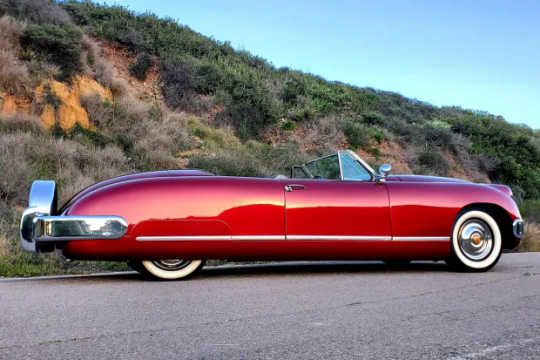
Custom 1953 Muntz Jet Convertible
The steel, aluminum, and fiberglass body is mounted on an Art Morrison ladder frame that was boxed and finished in semi-gloss black, and the floor was raised 3″. The exterior was repainted in a Sherwin Williams two-stage Apple Pearl mixed by the late Stan Betz. Features include a chopped Duvall-style windshield, 1950 Chevrolet headlights, dual Appleton spotlights, 1951 Ford Victoria side windows, and a white removable Carson-style top fabricated to match the height of the chopped windshield. Additional equipment includes color-matched rear fender skirts and chrome bumpers. Wear from fitting the top is noted on the rear deck.
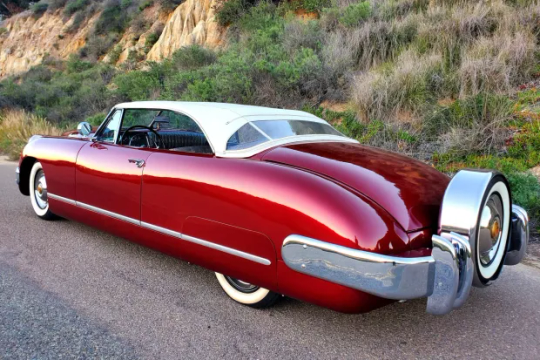
Custom 1953 Muntz Jet Convertible
Steel wheels sourced from a 1976 Dodge measure 15″ and are mounted with Cadillac Sombrero-style covers and whitewall tires. A matching spare fitted with a BFGoodrich Silvertown tire is mounted within a rear-mounted Continental-style chrome carrier. A Mustang II front end accommodates power rack-and-pinion steering , and the car rides on an electronically-adjustable Air Ride Technologies airbag suspension system along with 2” lowered front spindles, Strange Engineering tube shocks, a rear Panhard bar, and front and rear sway bars. The seller reports that the front control arm bushings were recently replaced.
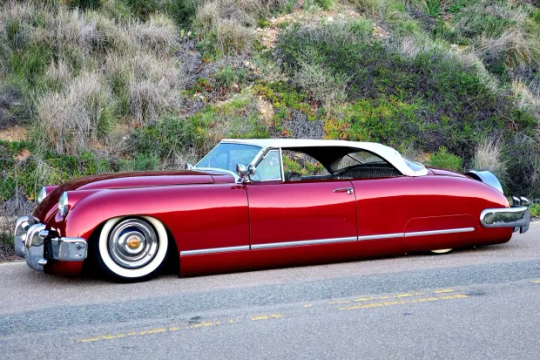
Custom 1953 Muntz Jet Convertible
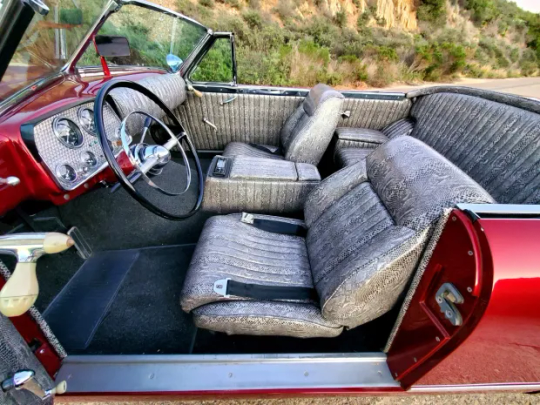
Custom 1953 Muntz Jet Convertible
Braking is handled by GM G-body-sourced calipers matched with Ford Granada discs up front and Ford SVO-specification calipers and discs at the rear.
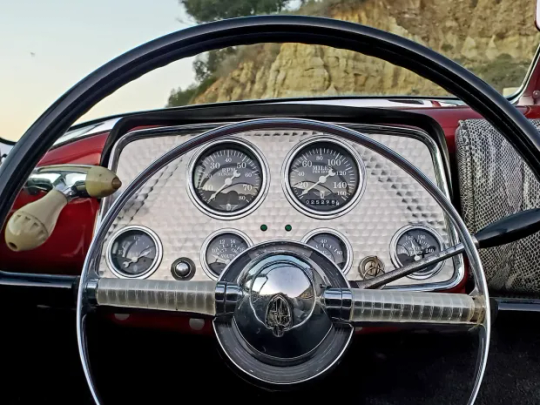
Custom 1953 Muntz Jet Convertible
The cabin was customized by Jim’s Auto Trim of San Diego, California, and features Glide bucket seats and a rear bench trimmed in gray snakeskin-style Naugahyde upholstery, along with matching treatments for the dash trim, headliner, and door panels. Additional equipment includes a 1952 Lincoln steering wheel mounted to a shortened Lincoln steering column, gray cut-pile carpet, and a Pioneer stereo housed within a custom center cubby.
The engine-turned “Hollywood” instrument cluster houses Stewart Warner gauges consisting of an 8k-rpm tachometer, a 160-mph speedometer, and auxiliary readings for fuel level, battery charge, oil pressure, and water temperature. The five-digit odometer displays 25k miles, though total chassis mileage is unknown. A Lokar pedal assembly was fitted during the build.

Custom 1953 Muntz Jet Convertible
The Corvette-sourced 5.7-liter LT1 V8 features a polished fuel intake manifold along with billet aluminum valve covers, and additional features include an Opti-Spark distributor, a Griffin aluminum radiator, and a wiring loom sourced from Painless Performance Wiring. A set of long-tube headers are connected to a 2.5″ exhaust system equipped with dual Dynaflow mufflers. The seller reports that the oil was recently changed.
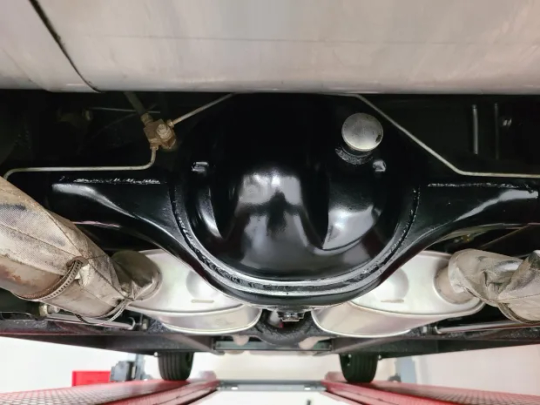
Custom 1953 Muntz Jet Convertible
Power is routed to the rear wheels via a four-speed 4L60E automatic transmission and a Ford 9″ rear end with with 3.55:1 gears and Strange Engineering 31-spline axles. Additional photos of the underside, drivetrain, and suspension components are presented in the gallery below.
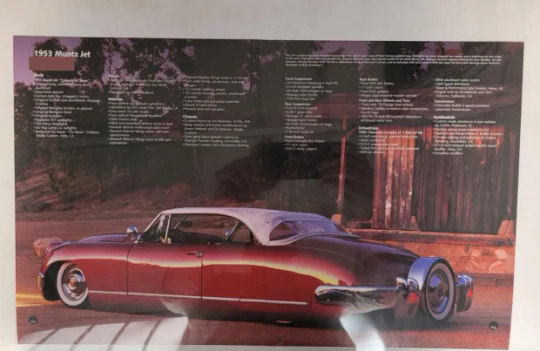
Custom 1953 Muntz Jet Convertible
The car was featured in issue #36 of Rodders Journal magazine
#Custom 1953 Muntz Jet Convertible#Custom 1953 Muntz Jet#Muntz Jet Convertible#Custom Muntz Jet Convertible#Muntz Jet#Convertible#car#cars#muscle car#american muscle
111 notes
·
View notes
Text




KC-135Q PILOT: SPECIAL BLACKBIRD PROCEDURES AND RESCUING AN SR-71
The lifeblood of the fastest airplane in the world was the JP7 fuel. It was in itself unique. What made it unique lies within the fuel, as it had a combination of ingredients that made it difficult to ignite. Because this airplane was so fast the faster you are the hotter you get. That is why you needed TEB to get it going.
A full tank of JP seven fuel will last in the SR 71 for about 60 to 90 minutes
How long the fuel would last would depend on atmospheric conditions and how fast the airplane was going. To be on the safe side usually, refueling would be about every hour
Never in the history of the SR-71‘s flying. Did they ever run out of fuel?
Once the boom connection was made, a light would come on in both aircraft indicating a good connection. The tanker copilot would then open the fuel panel line valve and turn on one of the forward or aft body fuel pumps. When a good indication of fuel flow was confirmed, all four pumps were turned on.
We were now pumping JP-7 fuel at a rate in excess of 6,000lb (2,721kg) per minute. It did not take long to offload between 45,000 and 65,000lb (20,412-29,484kg) of fuel that was needed. At the point the SR-71’s fuel tanks were almost full we would reduce the number of fuel pumps and fuel pressure at the request of the Blackbird RSO.
The SR-71 would generally move to the left side of the KC-135Q and begin acceleration and climb. At night it was a beautiful sight, watching the afterburners in the darkness. Quickly, all one could see was a rapidly disappearing glow of the afterburners as the Blackbird accelerated and climbed to operational altitude and airspeed. The job of the first of four KC-135Qs was done and we headed back to Mildenhall. The first tanker’s mission would last less than an hour and a half.
Differences with the ‘Q’
Outwardly the KC-135Q did not differ much from the KC-135A. Looking at a ‘Q’ one would only see a clear window on the underside of the empennage that housed a remotely controlled spotlight. This was used to help the boom operator locate the refuelling receptacle on the Blackbird at night. With the SR-71’s black body, in the black of night, in radio-silent conditions, it was often hard to clearly see the refuelling receptacle located some distance behind the cockpit.
On top of the forward fuselage was an antenna bump and a blade aerial. These were respectively the COMNAV-50 Command Ultra High Frequency (UHF) radio and the AN/ARN-90 air-to-air Tactical Air Navigation (TACAN). The COMNAV-50 and AN/ARN-90 enabled the KC-135Q and the SR-71 to conduct a radio-silent rendezvous giving range and direction out to approximately 300 miles (483km). These two pieces of equipment were backed up by the use of the aircraft’s weather radar and stopwatch timing.
During what we called a ‘hot refuelling’, in which the SR-71 was doing its supersonic scheduled descent coming down from 80,000ft (24,384m), the closure rate between the KC-135Q and the SR-71 could be upwards of 2,200mph (1,910kts). At 300 miles this only gave the Reconnaissance System Operator (RSO) in the back seat of the SR-71 and the tanker navigator around eight minutes to find each other, get the proper offset, and perform a precision rendezvous. The radio also had an Automatic Direction Finder (ADF) feature, which acted in concert with the TACAN as it could provide distance and bearing information to the receiver.
The COMNAV-50 was used in a classified manner on a pre-arranged frequency that would enable the SR-71 RSO to get a direction and distance from the tanker.
The COMNAV-50 and AN/ARN-90 were used simultaneously and were only effective for radio-silent operations if both aircraft had the same frequency set in their respective units. key.aero/article/kc-135…
Key Aero
Linda Sheffield
@Habubrats71 via X

#sr 71#sr71#sr 71 blackbird#blackbird#aircraft#usaf#lockheed aviation#skunkworks#aviation#mach3+#habu#reconnaissance#cold war aircraft
22 notes
·
View notes
Note
What’s the longest dive you have ever needed to complete for a rescue, and how did you handle fatigue and mental focus? It’s got to be incredibly difficult to have a complicated rescue that requires continued attention.
Ooh, big question (a very good one, thanks!)
I’ve done quite a few long trips that have meant staying at depth for a couple of weeks here and there, research trips and obviously back when I served with the WASPs. Not for an immediate rescue though as part of iR - It’s very different when it’s a rescue.
The longest rescue dive I’ve ever done in one stint was nineteen hours. That’s the record for me (and not one I’m eager to beat). It was off the Mariana Ridge. A deep-sea pipeline maintenance station had a catastrophic collapse - pressure door failure, electrical fire, you name it. There were six workers trapped in a reinforced chamber, two hundred metres below the surface. Scrubbers that were failing, a hull that critical - it was a race against time and physics.
The dive was brutal. Currents were wicked strong, the seabed was shifting, the structure was collapsing and the visibility was almost zero. I had to alternate between piloting Thunderbird 4 through a collapsed support grid and EVA’ing to try and stabilise the structure and make us room to get close. Absolutely no room for error. One wrong move and the entire thing could’ve gone down.
And here’s the thing most people don’t realize — it’s not just the currents, or the pressure, or the sheer isolation that wears you down. It’s the constant vigilance. For eighteen hours, I couldn’t mentally look away. Every second I was calculating: gas reserves, structural stress, movement patterns, pressure calculations, body positioning, welding and cutting. When you’re diving that deep, with that kind of responsibility on your shoulders, you’re always working. There’s no coast mode.
It’s the mental grind that really tries to get you. You’re thinking about how to gently cut through a collapsed bulkhead without triggering a chain reaction. What is going to happen if I release this valve? How is the pressure going to shift? What else has failed on that panel that I can see - is there a weak spot I’m not anticipating? How injured are the crew? Am I going to be able to stabilise them before they need to hit the surface? What am I going to do if I get inside this thing and someone’s too sick for that? How am I getting us all out if my entryway is blocked, what’s my plan B, C, D?
Because you’re always thinking about the voices on the other end of your comms - scared, breathing too fast, trying to believe someone’s coming. They don’t need to know how complicated it is on your side - they just need to know you’re coming for them.
I used very short windows back in Four, still at pressure, to do breathing drills - stretch, re-center myself, run diagnostics. It helps keep a clear head.
I manage fatigue the same way I manage everything else down there — through systems and rhythm. My suit is obviously pressure and temp controlled automatically. Four runs my monitoring remotely, but I hooked up to the umbilical for outside EVA’ing for that length of time. Saved swapping tanks, and it meant she could continue to adjust my gases for me as I worked, constantly judging my nitrogen levels for a mix of Tri and Hydrox. Takes some of the brain work away for me, and I trust her (and Brains’ engineering) without fault. I have an integrated hydration system (like a squid-friendly Camelback) so I have electrolyte fluids going (it’s just fancy Gatorade 😏). High-calorie, fast-absorbing nutrient gels every couple of hours. Caffeine tabs when I felt myself slipping.
I had my favourite playlist running low in one ear. Mostly instrumental stuff. Nothing that demanded too much brain space. And of course, John’s chatter about systems in the moments that didn’t require that intense, silent focus, and Virgil’s absolutely terrible ocean themed puns. And this is why they’re so damn excellent at what they do - John knows when to stay quiet or when to chime in with a report back on something, and Virgil just knows me in the field like nobody else, I don’t have to explain everything, he anticipates it.
Scott, on the other hand, was actually blocked from comms at one point because I was sick of hearing my own name and having to reply every five minutes because he was convinced I was dead. He was somewhere between strangling me and having kittens by the time I re-surfaced, I think it may have been more peaceful under the water 😏
The actual extraction took nearly six hours. Had to flush one of the pipelines and use it as my way in which was… yeah, until I’d actually got into it and made sure it was totally clear of the gas, I was sweating, won’t lie. It was pitch black, only had my headlight and (look away now if you’re claustrophobic) tight enough that it was a bit of a wiggle at the bends, shoulder to shoulder touching kind of stuff. Really, navigating through it by touch and feel, before there wasn’t enough space to turn my bed properly or lift my arms.
Once I was inside, I stabilised all of the crew and then one by one, guided each of the guys back out through that pipeline. That was tough. Most of them were injured, all of them were cold and hypoxic, and (again, claustrophobics of the world, shield your eyes), being dragged backwards through a flooded pipeline in the dark, unable to lift your arms and with the wall just inches off your nose is terrifying. Took a lot of my signature chatter to get us all through that one.
But each safe rescue is an adrenaline boost - you move with the wins, however small or big they are. Break it down into steps. It keeps you going. Each crewmember safe in the back of Four was a huge push to carry on, despite the fatigue and exhaustion and discomfort. And in the end, the massive satisfaction of a job well done when there’s six men returned safely to their families.
And I was exhausted 😂 I slept off my decomp after I’d got the crew to the surface. Sound asleep in my kit on the floor in the back of Four. 11/10, best sleep of my life. Virgil gave me a piggyback to the medbay once I hit the top and let me go back to sleep 😂
Once again, Scott thought I was dead. I was, in fact, alive and well- as my suit reported, but why allow fact to get in the way of a good smotherhenning? 😏 I fell asleep on one of the loungers by the pool and I swear he was on patrol to make sure I was still breathing.
#excellent question!#thanks anon#thunderbirds rp#thundersocials#gordons squid thoughts#tw claustrophobia
16 notes
·
View notes
Text

Valve has released a 20th anniversary update for Half-Life 2.
Half-Life 2 with Episode 1 & 2 are free to own on Steam until November 18, 2024 10AM PT / 1PM ET.
Overview
BRAND NEW INTERVIEWS WITH THE HALF-LIFE 2 DEV TEAM!
Our Half-Life 1 25th anniversary documentary went so well that we invited Secret Tape back to make another one—this time focusing on Half-Life 2. And it's about a lot more than just the making of a game. Running out of money. Getting hacked, and an early version being leaked online. Being sued by our publisher. Trying to build Steam. It's all in there!
youtube
THE 20TH ANNIVERSARY UPDATE FOR HALF-LIFE 2 INCLUDES:
EPISODE ONE AND TWO EXPANSIONS IN THE BOX
Half-Life 2 now includes the complete Episode One and Episode Two expansions along with the base game. They’re accessible from the main menu, and you will automatically advance to the next expansion after completing each one.

HALF-LIFE 2 DEVELOPER COMMENTARY
When we shipped "Lost Coast" a year after Half-Life 2, we included an interactive developer commentary mode to offer interested players a deep dive into the new technology that inspired the demo. We did it again for every Half-Life and Portal game afterwards, but Half-Life 2 itself never had commentary... until now. We got the original HL2 team back together to record brand new commentary tracks for the whole game.
STEAM WORKSHOP SUPPORT
Browse, install, and play user-created content for Half-Life 2 without ever leaving the game. Look for it in the Extras menu!
STEAM GAME RECORDING
Preserve your precious memories of City 17 with the help of Steam! Take a look at the Game Recording timeline in your Steam Overlay for event markers that commemorate big and surprising moments in your playthrough.
UPDATED GAME CONTENT
Every map in Half-Life 2 has been looked over by Valve level designers to fix longstanding bugs, restore content and features lost to time, and improve the quality of a few things like lightmap resolution and fog:
Fixed pops, holes in the world, fading-out and disappearing objects across the game.
Rebalanced the lighting across Half-Life 2 to account for playing with HDR on or off, using the original release as reference.
Cleaner, smoother horizon lines thanks to new radial fog!
Added higher-resolution lightmaps across the game!
Removed green glow from the G-Man model’s eyes in the opening of the game, and restored the reflective glint as seen in the original release.
Fixed missing grass sprites and blacked-out models throughout the game!
UPDATED GRAPHICS SETTINGS
Choose either the original launch day blood and fire effects, or those created for the episodes, when playing the Half-Life 2 base game!
Play with only the highest detail models in High Quality mode!
Get smoother lightmap shadows at Very High shader detail, thanks to new bicubic lightmap filtering!
GAMEPAD, INPUT, AND STEAM DECK UPDATES
Gamepad controls have been updated to match the Half-Life 1 anniversary update.
Aim Assistance has gotten an overhaul making it feel better to use, and there are more configuration options available. Aim Assistance can be enabled separately for gamepad or mouse/keyboard input. The amount of assistance can be tuned up and down, and it’s no longer tied to a skill setting. Want to play on Hard with high aim assist, or Easy with it off? Knock yourself out.
The Steam Deck main menu has been updated with all of today’s additions including the Episodes, Workshop, and new input configuration. The Steam Deck version of the main menu will also appear when you play Half-Life 2 on a PC running Big Picture Mode.
LONG-LOST LOOKS INTO HALF-LIFE 2'S DEVELOPMENT
WATCH OLD VIDEOS FROM THE EARLY DAYS OF HALF-LIFE 2
We rescued these old demos from the hard drives of ancient computers scattered around the office, and are offering them up as high quality videos:
youtube
E3 2003
The demo that revealed Half-Life 2 and the Source engine to the world. This was previously only available as shakycam recorded from our E3 booth, now available as direct capture.
youtube
E3 2002
We built this demo to bring to E3 a year earlier, and then decided at the last minute we weren’t ready to show the game. 20 years later, we’re okay with you seeing this stuff.
youtube
SIGGRAPH 2000
Also known as the “Free TVs” demo, this was shown at the SIGGRAPH computer graphics conference, hot on the heels of the release of the original Half-Life. This is the highest quality video we’ve still got from this era of Half-Life 2’s development.
RE-RAISING THE BAR
A NEW EDITION OF RAISING THE BAR IS COMING BACK INTO PRINT IN 2025, EXPANDED TO INCLUDE THE HALF-LIFE 2 EPISODES
Nearly two decades since it first went out of print, Raising the Bar is set to return with an expanded second edition—offering a comprehensive look into the creation of the Half-Life 2. Originally published in 2004, this book captured the story of Half-Life 2's development but missed the episodic content that followed.
This new edition concludes the Half-Life 2 development story, with never-before-seen concept art from Episode One and Episode Two, along with ideas and experiments for the third episode that never came to be.

---
Looking for something to read right now? The Final Hours of Half-Life 2 was written twenty years ago by Geoff Keighley after spending time in Valve's offices during... you guessed it.
---
BUG FIXES AND CHANGE NOTES
Content
Added 3.5 hours of Developer Commentary by members of the Half-Life 2 team.
Half-Life 2: Episode One and Episode Two are now playable from the Half-Life 2 main menu.
Half-Life 2: Lost Coast has been added to the Extras menu.
Added Steam Workshop support. Play entire campaigns or replace weapons, enemies, UI, and more with content created by the community.
Added custom Steam Game Recording gameplay events and phases throughout the game.
Rendering and Graphics
Fixed issues causing props or entire maps to be fully bright or fully dark depending on settings.
Added bicubic filtering for lightmaps to produce smoother shadows. It can be enabled by setting Shader Detail to Very High.
Fixed missing grass detail sprites in many maps.
Added settings to enable Classic Effects that were originally in Half-Life 2. These effects can also be enabled using r_classic_blood or r_classic_fire.
Added support for radial fog.
Specular reflectivity has been adjusted throughout Half-Life 2 to better match the original release.
Updated models for the Crossbow and RPG weapons to support ultrawide displays.
Fixed camera clipping into vehicles at high FOV settings.
Fixed lambda cache indicators and other decals vanishing when backtracking through map transitions.
Setting Model Detail to High will now always display the highest detail version of a model and never swap for a lower level-of-detail.
Set Antialiasing to 4x MSAA by default.
Fixed teeth shader rendering fully white on some GPUs.
UI and Options
The UI now scales to support higher resolutions.
Launching the game in Steam Big Picture mode will now use the gamepad-friendly UI previously available on Steam Deck. You can also launch this mode with the "-gamepadui" launch option.
The High Dynamic Range setting has been moved to the main Video settings page.
Commentary mode can now be enabled on the New Game screen.
Fixed display of greyscale art for locked achievement icons to match their behavior in steam.
Improved legibility of gamepad button icons.
Button hints will now prefer to display standard face buttons and trigger icons only. This behavior can be disabled with the "sc_prefer_basic_origin_hints" convar.
Replaced instances of system fonts like Verdana throughout the UI with a new font, GorDIN.
Added a new font renderer that provides more consistent rendering between platforms.
Fixed edges of certain font characters being cut off with antialiasing enabled.
Fixed scrollbars and button animations using inverted colors.
Removed the non-functional "Use 'bloom' effect when available" setting.
Added Rich Presence info while playing Half-Life 2.
Input
Updated the default Steam Input configuration.
Added a Gamepad settings menu.
Added the ability to select a weapon selection UI style while using a gamepad.
Added settings for separate Aim-Assist modes for mouse/keyboard and gamepad. The new Aim-Assist "Enhanced" mode now attempts to track enemies and snap-to-target while driving vehicles.
If using toggle crouch, pressing sprint will now make the player stand.
Legacy joystick settings have been removed from the Mouse settings menu.
Gameplay
Reduced chances of birds getting stuck in the world.
Fixed Combine crouching behavior during door assault scene.
Fixed Combine not firing in some cases during the finale.
Game sounds and music now pause while the game is paused.
Fix crash that can occur if the player gets too far ahead of the helicopter in canals.
Fixed Dr. Breen not looking at the camera in certain broadcasts.
Fixed smooth friction sounds not playing.
General Map Updates
Full HDR lighting and tonemapping pass across every map in Half-Life 2 and Half-Life 2: Deathmatch.
Increased lightmap resolution in most maps.
Adjusted rendering distances across the game so details and objects remain visible much further away.
Removed Far-Z clip plane from most maps.
Increased window and door fade distances.
Improved lighting and world detail inconsistencies during many map transitions.
Tuned fog and skyboxes for every map with water on the horizon for better horizon blending.
Replaced instances of simple reflective water with fully reflective water in nearly every map.
Fixed many instances of floating props across the game.
Sewed up holes, aligned textures, and fixed seams on many displacements throughout the game.
Swapped some distant trees out for higher detail models.
Enabled shadows on many static props that were missing them.
Added glow sprites to all lights that were missing them.
Fixed lightmapping for many large static prop structures.
Added simple rooftop geometry to background buildings that were missing them.
Added background displacement geometry to areas which are now exposed by removed the clipping plane.
Specific Map Updates
The introduction sequence has been adjusted to closely match the original sequence, including fixing specular highlights on the G-Man's eyes.
Fixed various texture seams on train station wall
All fences now properly cast shadows.
Fixed issues with level transitions setting fog values improperly.
Removed emissive value from base of lighting prop which was glowing in strange places.
Fixed a bug with Eli's idle animations during the teleport sequence.
Fixed lightmapping of train cars in Red Letter Day and Route Kanal.
Fixed a rendering bug in Route Kanal where world geometry would pop in and out of view when looking down the tracks.
Aligned pipe and canal wall textures in a few areas to reduce seams and misalignment in Route Kanal.
Added and adjusted canal wall brushes where level geometry was conspicuously missing.
Adjusted brightness and falloff of ambient lights in darker sections of the canals.
Added small grates as dim light sources of ambient light in a few places in the canals.
Fixed an issue where the splash for Manhack Matt's jump into the water would be out of sync.
Fixed a bug where the large brick smokestacks were popping in and out depending on the player's position in Water Hazard.
Added missing cables to utility poles in various canal maps.
Fixed lighting and shadows on the dock and electric tower outside of Black Mesa East.
Added displacements and water plane to 3D skybox near the dam entrance to replace simple brush cliff face.
Fixed the lighting on the rocks and props in and around the Ravenholm graveyard.
Fixed players being able to trap themselves in the graveyard by closing the gate after Gregori would open it.
Added radial fog to all coast maps in the Highway 17 chapter.
Removed area portals from many of the smaller structures along Highway 17.
Fixed a crash that would occur if you parked the buggy in certain areas before entering the bridge level.
Fixed a bug where Vortigaunts could fall through the world.
Added simple 3D skybox representation of the next map visible from the top of the lighthouse in Sandtraps.
Fixed lighting issues during the basement flare sequence in Nova Prospekt.
Added additional geometry to various windows throughout the levels to cast more detailed shadows in Nova Prospekt.
Fixed a bug in teleport sequence in Entanglement ending too early leaving Gordon and Alyx standing around while the teleporter reached its destination.
Fixed the catwalk explosion detonating at the wrong time in Anticitizen One.
Fixed the building dome having no polygons on the outstide in Follow Freeman.
Fixed the ship visibly flying through the building dome in Follow Freeman.
Fixed Barney being left behind during a level transition or nagging the player too early to "roll a grenade" in Follow Freeman.
Improved resolution of portal render texture during finale.
Added soundscape to all menu background maps
Darkened parts of the skyboxes that fall behind Half-Life 2 logo to help with text legibility.
Added geometry to menu background maps for Ultrawide support.
Added smoke to the Ravenholm and Follow Freeman background maps.
Fixed a bug where you could hear the player's bones break in the Citadel menu background map.
Half-Life 2: Deathmatch Fixes
Fixed player model selection in the options menu.
Fixed slam not being able to be detonated if you were too close to a wall
Fixed view bob with the SMG equipped.
Fixed using the Gravity Gun to yo-yo grenades, sometimes causing the server to disconnect or crash.
Fixed missing sound effects for the Gravity Gun.
Fixed characters playing a missing animation when switching weapons while jumping and moving.
Fix weapons being invisible when being given another weapon of the same class.
Half-Life 2: Deathmatch Maps
Increased player spawn point count in many maps.
Fixed prop placement in maps that would allow players to escape the world.
Fixed floating props in dm_runoff.
Fixed the area portal on the blast door in dm_runoff causing the world to no longer render when the door was shut.
Added geometry to many maps where the player could see outside of bounds.
Fixed several areas where the player could see out of the world.
Moved the blue barrels in dm_resistance that you could pick up with the Gravity Gun through the chainlink doors.
Other
Improved quality of the Valve intro movie when launching the game.
Fixed playback of the the post-credits movie at the end of Episode One and the intro movie at the start of Episode Two.
The achievements for Episode One and Two have been added to Half-Life 2. When launching the game it will attempt to read data from installed standalone Episodes to re-grant those duplicated achievements.
Hammer: Show detail sprite preview on non-displacement surfaces.
Hammer: Fixed bug where orphaned entities added additional data on each map load.
Hammer: Fixed the ability to render cubemaps.
Hammer: Increased many limits for BSP data. Models 1024 -> 2048, Brushes 8192 -> 16384, TexInfo 12288 -> 16384, TexData 2048 -> 8096, DispInfo 2048 -> 8096.
Added save_transition_music convar that allows streaming music to continue to play in between level transitions.
Localization files updated.
Miscellaneous security fixes.
Notes
The previous version of the game has been archived to a publicly visible Beta branch named "steam_legacy", with the description "Pre-20th Anniversary Build." If a mod or feature is behaving in an unexpected way, you may need to run this archived build until the issue is resolved in the default build.
With the Episodes and Lost Coast now contained within Half-Life 2 itself, we'll be reducing the visibility of the standalone versions on the Steam Store. The old standalone applications will remain available to ensure community projects that rely on them still function properly but they will now appear within the Tools menu on your Steam Library.
WALLPAPERS
Celebrate 20 years of Half-life 2 by decorating your desktop and mobile phone.


























HALF-LIFE 2 SOUNDTRACKS

#Half Life 2#HL2#Half Life#Valve#Valve Corporation#video game#Steam#PC#free games#late post#long post
25 notes
·
View notes
Text
Top Automatic Water Valve Control Systems for Industrial Applications
In today's industrial landscape, managing water flow efficiently is crucial for operations in a variety of sectors, including manufacturing, agriculture, and utilities. One of the most effective ways to achieve this is through the use of automatic water valve control systems. These systems are designed to regulate water flow, pressure, and distribution automatically, ensuring optimal performance, energy efficiency, and cost savings for industrial facilities.
In this article, we will explore the top automatic water valve control systems available for industrial applications, highlighting their benefits, key features, and how they can improve operational efficiency.
What is an Automatic Water Valve Control System?
An automatic water valve control system is a sophisticated device designed to control the opening and closing of water valves automatically, based on predefined conditions such as pressure, flow rate, and level. These systems are typically integrated with sensors, controllers, and actuators, allowing them to adjust water flow without the need for manual intervention. The result is a more efficient and reliable water management system that minimizes human error, reduces energy consumption, and enhances operational safety.
Benefits of Automatic Water Valve Control in Industrial Settings
1. Increased Efficiency
Automated water valve control systems are designed to optimize water flow based on real-time conditions, ensuring that water is only used when and where it's needed. This reduces the risk of overuse or waste, which is particularly important in industries where water is a critical resource.
2. Cost Savings
By automating water flow control, businesses can reduce their energy consumption and lower operational costs. Automated systems eliminate the need for manual monitoring and adjustments, reducing labor costs while ensuring more consistent water use and pressure regulation.
3. Improved Water Quality
Automatic valve control systems can help maintain consistent water pressure, which is essential for ensuring that the water quality remains within acceptable standards. By automatically adjusting water flow, these systems prevent fluctuations that could potentially affect the integrity of water systems and products.
4. Enhanced Safety and Reliability
Automatic water valve control systems also contribute to the safety of industrial applications by preventing over-pressurization, leaks, or system failures. By constantly monitoring and adjusting water flow, these systems help ensure that equipment operates within safe limits, reducing the risk of accidents or damage.
Top Automatic Water Valve Control Systems for Industrial Applications
1. Electromagnetic Water Valve Systems
Electromagnetic water valve systems are highly reliable and efficient, using electromagnetic actuators to control water flow. These systems can be operated remotely, making them ideal for large-scale industrial operations where manual control is impractical. Electromagnetic valves are known for their precision and quick response times, ensuring that water flow is adjusted in real-time based on changing conditions.
2. Pneumatic Water Valve Control Systems
Pneumatic valve control systems use compressed air to actuate valves, offering a high degree of control and flexibility. These systems are commonly used in industries such as oil and gas, where precise water flow regulation is essential. Pneumatic systems are highly reliable, require minimal maintenance, and can be adapted to a wide range of industrial applications.
3. Hydraulic Water Valve Control Systems
Hydraulic valve control systems are ideal for industrial applications requiring high-pressure water flow. These systems use hydraulic fluid to power the valve actuators, providing strong and consistent force. Hydraulic systems are particularly beneficial for industries that require robust control over water flow and pressure, such as in power plants or large manufacturing facilities.
4. Motorized Water Valve Control Systems
Motorized valve control systems use electric motors to open and close valves based on preset parameters. These systems are easy to install and integrate with existing water distribution networks. Motorized valve control is often used in applications where high precision and automated adjustments are necessary, such as in chemical processing plants or water treatment facilities.
5. Smart Water Valve Control Systems
Smart water valve control systems represent the next generation of automation. These systems are equipped with IoT (Internet of Things) technology, allowing them to be monitored and controlled remotely via smartphones, tablets, or computers. With real-time data collection, smart systems enable predictive maintenance and more efficient management of water resources. These systems are ideal for industries looking to implement sustainable water practices and improve operational efficiency.
Q&A: Common Questions About Automatic Water Valve Control Systems
Q1: How do automatic water valve control systems improve industrial efficiency?
Automatic water valve control systems improve efficiency by regulating water flow based on real-time data. This ensures that water is only used when necessary, preventing overuse and reducing the likelihood of system failures. By automating the process, businesses can also eliminate manual monitoring, freeing up labor resources for other tasks.
Q2: Are automatic water valve control systems difficult to install?
While the installation complexity depends on the type of system and the specific industrial application, most automatic water valve control systems are designed to be easy to install and integrate with existing infrastructure. Working with an experienced system provider can ensure a smooth installation process and proper configuration for optimal performance.
Q3: What are the maintenance requirements for these systems?
Maintenance requirements vary based on the type of system, but generally, automatic water valve control systems require minimal maintenance. Regular inspections, cleaning, and calibration are recommended to ensure the systems continue to perform optimally. Smart systems may also include self-diagnostic features, allowing operators to monitor system health and detect potential issues early.
Conclusion: Invest in the Best Automatic Water Valve Control Systems
For industrial applications, having an effective water valve control system is crucial for optimizing operations, reducing costs, and ensuring safety. Whether you choose an electromagnetic, pneumatic, hydraulic, motorized, or smart water valve control system, these solutions offer significant benefits that will improve the overall efficiency of your water management processes.
Investing in an automatic water valve control system can enhance your business's bottom line, improve resource management, and ensure reliable water distribution. If you are looking to upgrade your industrial water systems, consider working with a trusted provider of water valve control solutions to find the best fit for your needs.

#water leak detectors residential#water leak detection#water heater automatic shut off valve#automatic water valve control#commercial leak detection#water leak stop#water pipe automatic valve#residential water leak detectors#WaterValveSystems#IndustrialWaterManagement#WaterFlowControl#PneumaticValves#SmartValveSystems#HydraulicValveControl#WaterEfficiency#IndustrialAutomation
0 notes
Text
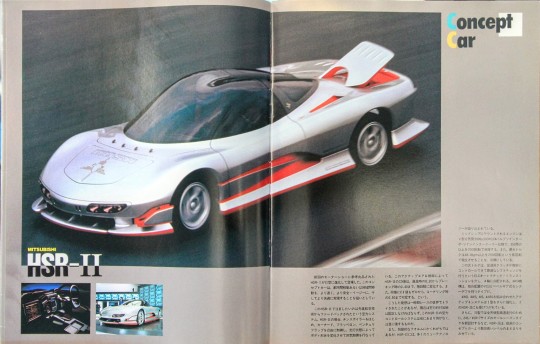
Mitsubishi HSR-II Concept car.
The HSR-I, which was exhibited as a concept car at the last motor show, has evolved into the HSR-II model. This concept car aims to make intercity or interregional travel faster, safer, easier, and more comfortable.
The HSR-II's aerodynamic system, which was developed based on advanced aviation technology, is noteworthy. The HSR-II can freely control the chin spoiler, canards, flaperons, and venturi flaps, and changes the body shape depending on the driving conditions to control the airflow.
This active aerodynamic control allows the HSR-II's CD value to vary steplessly from 0.20 when going straight to 0.40 when braking. Similarly, the Cℓ value can be varied from zero to 0.50 when cornering.
This idea was once tried out in the racing world, but nowadays any aerodynamic additions must be fixed, making the HSR-II's aerodynamic control system unique and noteworthy.
Although it tends to be hidden by its unique form, the HSR-II incorporates many new technologies.
It's packed with technology.
The midship-mounted engine is a 3000cc V6 DOHC 24-valve twin intercooler with twin tamper-exchange mechanism that produces over 350 horsepower at 7000 rpm. The maximum torque is targeted to be over 45.0 kgm at a low 2500 rpm.
This large torque is distributed to all four wheels via an ELC automatic transmission, which allows the clutch to be delicately controlled for optimal shifting. The 4WD system is a type with a uniquely positioned VCU and bevel gear type center differential.
The Active 4 system, which combines 4WD, 4WS, 4IS and 4ABS, further strengthened the first model and was also inherited by the second model, HSR-II.
Furthermore, the Type II model features newly designed 245/45R17 all-season tires for all-weather high-speed driving, giving the HSR-II a level of cohesion several steps higher than conventional concept cars.
6 notes
·
View notes
Note
Alright it’s time to get freaky about Sentinel.
I want to make him my wife. He’s the absolute worst and a total aft, but just imagine. Bending him until he breaks. Training him until he’s an obedient little slut.
It starts off with him pushing back and scoffing at every attempt to correct his bad behavior, but then you offer the right rewards… He wants power, so you promise to give it to him. If he behaves, if he just indulges you a little bit, he’ll be praised for it and can have his fun dominating you in return.
But first he’s gotta get on his knees for you. He tries to look smug, claiming this isn’t gonna be a regular thing. But he’s lying to himself. He doesn’t even realize when it’s shifted from him submitting so he can get rewarded to now submitting because that is his reward.
By the time his himbo processor has caught up to him, he’s already halfway trained. Responses to certain phrases are practically automatic and he finds himself getting distracted by the thought of pleasing you just to get a taste of praise.
Eventually he’s the perfect housewife. He doesn’t go out anymore because he’s gotta get all the housework done by the time you’re home or he won’t get any attention, and he couldn’t stand that.
When you do return, he’s already waiting, eager to assist in whatever way you request. Imagine him trying extra hard to please you and as a reward you bring home another mech for him. Someone bigger and stronger who will absolutely ruin his valve.
You don’t have to tell him twice. Soon he’s on his hands and knees being fucked hard and fast, whining and moaning around the massive spike filling him. He looks pathetic, and you make sure he knows it before stealing some wet kisses as he moans into your mouth.
You get to sit back and relax, doing whatever you feel like and admiring his incoherent babbling. Sure fucking him is fun, and you could fuck him in a mirror to see his reactions. But there’s just something about making him put on a show like this that satisfies a lust for control.
To think he was once a power hungry jerk who rarely took you seriously. Now he’s getting fragged into oblivion, begging to be bred so he can be the perfect wife for you, working around the house barefoot and pregnant.
Now that would be a pretty picture.
hoooly shit. yes. we need to make sentinel undergo some wifeication. i can fix him (<- make the perfect little housewife out of him)
At first it’s a game that he’s convinced he has the upper hand in. He gets on his knees, plays semi-nice, thinks about how he’s going to make you pay him back for the vile things you’re doing to his spike and valve…
By the time he realizes the footing is never going to switch, it’s far too late. Every time you come home, Sentinel already has his hands on the counter and his hips popping out, obediently waiting for your spike. Far enough into his training he knows better than to complain about you taking your time, so he bites his tongue, though you could argue that his clicking the latch on his locked panels desperately can be counted as Sentinel being pushy. Sometimes you fuck him, sometimes you just make him suck you off. At first he’d ignore it, lying to himself how he doesn’t need to feel a spike in his valve everyday. Then later he’d get angry and bitchy about it, but that behaviour could cost up to a month without a spike in his valve, so he just obediently sucks, a hint of resentment in his eyes, and he hopes that next day you’ll give him what he needs…
When he’s being a very good wife he gets a toy in his valve while you’re gone, but he’s not allowed to play with himself, because you know otherwise he’d forget his chores, and by telling him that you basically ensure he never does play with himself. Because Sentinel is not some slut who can’t handle a few hours without having his valve fucked, he’s not. (the sopping wet mess his valve turns into when you come home begs to differ…)
mhmmm Bringing in a bigger mech to fuck him. Sentinel with his hips in the air and head pushed to the floor, and he doesn’t even have to be told to keep his mouth shut and take it. You remind the guy to not finish inside, not even when Sentinel starts begging for it. That’s going to be your job, once he’s thoroughly fucked out and covered in a stranger’s transfluid, you fuck him, finish inside, and make him thank you for it. All of his previous smugness, all his goading and dickish remarks are now fucked out of him, and he shakily thanks you without even thinking about it, giving no struggle.
Sentinel growing a pretty little baby-bump over time, and now he absolutely cannot go outside, not looking like this, but that’s not a problem for you. Or him, for that matter. He enjoys having his pregnant belly propped up on the kitchen counter while getting fucked, loves having it rubbed from behind, loves putting a hand on the underside to hold it up when it gets too heavy. You come home everyday to a clean house and a pregnant wife <3
#i had a really crazy sex dream last night and i’m convinced it was this ask trying to project itself into my mind while i was sleeping#valveplug#pregnancy mention#hi everyone come be normal about tfa sentinel with me
45 notes
·
View notes
Text
Emotions finally aside because we don't have those here...
The absolute paradox of my existence strikes again for the millionth millennia in a row. Every single thing was lined up, every calculation played out. I have an entire web-machine laid out of fractalised mathematical spell data at least seven instances deep, in some places. No. It's at its core - purposefully - three layers deep as a triangle binding, strength and ability to withstand the moving Sky - that is the tectonic-plate-esque movement of the Great Planes against each other, they shift - but in places it goes seven deep and onwards. Talking, of course, sustained and specially-written, overseen, layers of written out data, because it naturally fractalises into auto-generated data. And this was, as I said, machine spells. This is automatic intelligent self-expressing... It isn't.
Servants oversee its dispatch into reality. In fact, I've about what, 20 different archetypes as lubrication and centipedal carriers to move it valve-esque into the heart of reality. "20" is hard to translate because it's a symbol-number. I have Kali at the gateway.
They told me this day, Friday the 23rd, and other numbers lined up externally to it. Intense visions and feelings, swallowing, repetitive affirmative answers. Ananda through divination had been telling me before that something was wrong and I didn't trust her, she said though repeatedly today was the day and all was as I felt it was.... The result: Zero. No change at all on this plane.
Budding anger, to say the least, mostly because I have been asking people to not lie to me about this working and I have been... misled. Likely by myself. I will take blame whether it's actually mine or not.
It simply cements something I've suspected for a while... the grip I have over this Plane's workings and back-end are infuriatingly diluted - and yet note what I said in the beginning. Paradox, for the millionth time. I am perfectly in control, and in being so I am utterly out of it. Congratulations, new life, on discovering the annoyance that is this miserable in-between existence. Nothing irritates me more than the half-done and the doable-yet-undoable.
I've attempted to change course more times than I can count over the last one and a half months or however long. Autumn is supposed to be migration time and now... If I could readjust, I would. I've offered to. [Something higher than me] damnit let me point my horns at something and gore it.
2 notes
·
View notes
Text
Really annoying to watch in real time as hyped up tech investors artificially stretch the ai bubble by just... Redefining "ai" to include any new useful software so they can go "look at the potential of ai!" and act like Enhanced Autocorrect chatgpt still has potential to revolutionize workplaces.
Like. An article about using "ai" in farming talks about image analysis to catch disease or count leaves to measure plant health - which is actually an ai thing, but related to analysis not generating text/images. But then it also talks about "Smart Apply" spray systems that have sensors to more effectively target leaves and not waste spray in open air and that's like. That is detecting light and running an algorithm to spray where there is less light (so it turns off when you drive past a gap). I'm sure they've been refining the algorithm but we've had "turn this off when it detects too much light" for a long fucking time. If they have added any "ai" to that (to better differentiate foliage density?) it's significantly less "smart" and even further from resembling chatgpt.
And then they talk about "ai" irrigation systems which are just automatic water pumps with software that gathers data. It has auto shutoff if water flow passes X. It sends a ping about a suspected leak if Y doesn't equal Z. That's literally just automation software. That's "your microwave does X amount of energy for Y minutes unless the door opens and triggers auto shutoff". The only thing *maybe* "ai" is that the valve "learns" typical water use, and that could also just be a guy pulling up the usage data because the only system in which your valve is making decisions is if you have a separate ai system like the first one doing leaf health analysis that then automatically sets the irrigation level for the day because the plants seemed dry. Which is a totally different feature only vaguely alluded to and not part of the automatic irrigation system. Which you can definitely get sans ai because the features you have described as revolutionary are just normal enhancements of normal control software.
And none of this is remotely the same thing as the random plug about using chatgpt to develop, label, and price a wine bottle. Which why the hell would you use Enhanced Predictive Keyboard Text chatgpt to do that?
I mean, I know "artificial intelligence" is a buzzword and not a distinct thing, but running an algorithm to operate a system used to just be called adding a computer, and we were aware that computerizing one process for efficiency did not stop a completely different computerized process from being an ineffective waste of money that people probably shouldn't have invested in.
#it's the fact they always plug chatgpt like it is somehow related or intrinsic to the automation capabilities#when generating text or images has nothing to do with anything involved?#and you *know* it's the mad scramble to make sure all the investors in 'what if a computer read and replied to my emails badly' stay rich#by pretending the computerized stuff you've been interacting with for years is somehow being made better by 'bad email program'#and not just improving on it's own *existing* programs#technology#ladyluscinia
3 notes
·
View notes
Text
Audrey Lets Off Some Steam!
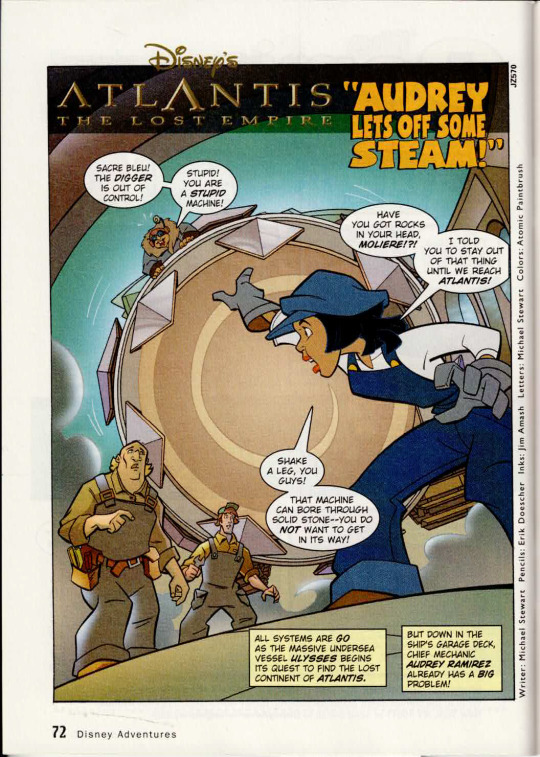

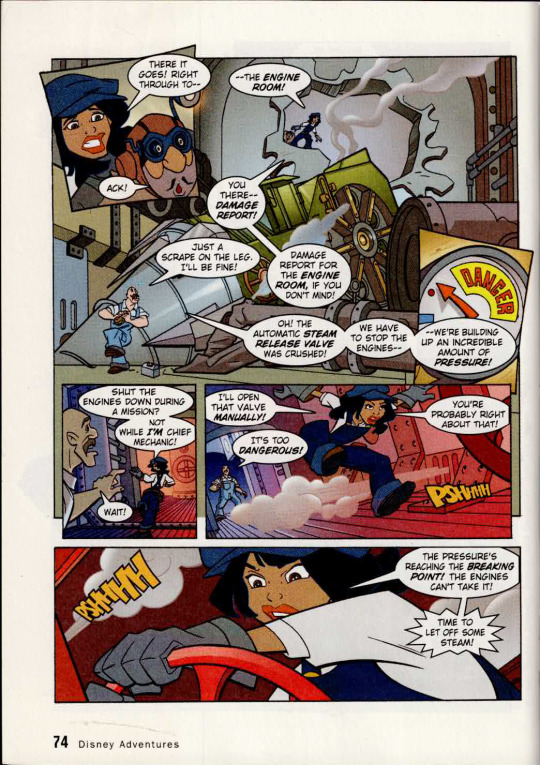

Written by: Michael Stewart Pencils by: Erik Doescher Inks by: Jim Amash Published in: Disney Adventures Collector’s Issue! Atlantis: The Lost Empire Volume 11, Number 6 (pg.72-75). Publisher: Buena Vista Magazines Inc. Publication date: circa July 2001.
Text:
Page 1: Mole: [Sacre bleu! The Digger is out of control!] [Stupid! You are a stupid machine!] Audrey: [Have you got rocks in your head Moliere!?!] [I told you to stay out of that thing until we reach Atlantis!] [Shake a leg, you guys!] [That machine can bore through solid stone--you do not want to get in its way!] Narrator: [All systems are go as the massive undersea vessel Ulysses begins its quest to find the lost continent of Atlantis.] [But down in the ship's garage deck, chief mechanic Audrey Ramirez already has a big problem!]
Page 2, Panel 1: Milo: [Excuse me, I'm Milo Thatch, the new ship's linguist] Audrey: [Good grief!] Milo: [I was looking for the crew's quarters, but I got a little--] Panel 2: Milo: [--lost.] [Oh my!] sfx: grab! Panel 3: Mole: [This is not happening] Audrey: [Out of the way, linguist!] [Or don't you know the meaning of the word "squashed"?] Milo: [Oof!] Panel 4: sfx: KER-SMASH! Audrey: [Why are you running a digger in my garage, Mole?] [You figure maybe Atlantis is hidden on the other side of that bulkhead?] Mole: [Now I must go!] [So much to do!] [Preparations to be made--on the other side of the ship!] sfx: VRRRRRRRR
Page 3, Panel 1: Audrey: [There it goes! Right through to--] Mole: [Ack!] Panel 2: Audrey: [The engine room!] [You there--damage report!] mechanic: [Just a scrape on the leg, I'll be fine!] Audrey: [Damage report for the engine room, if you don't mind!] mechanic: [Oh! The automatic steam release valve was crushed!] [We have to stop the engines--] Panel 3: text: DANGER mechanic: (from offscreen) [--we're building up an incredible amount of pressure!] Panel 4: Audrey: [Shut the engines down during a mission?] [Not while I'm chief mechanic!] mechanic: Wait! Panel 5: Audrey: [I'll open that valve manually!] mechanic: [It's too dangerous!] Audrey: [You're probably right about that!] sfx: PSHHHH Panel 6: sfx: PSHHHH Audrey: [The pressure's reaching the breaking point! The engines can't take it!] [Time to let off some steam!]
Page 4, Panel 1: Narrator: [Once the immediate danger is over...] Audrey: [Hoist that hunk of junk back to the garage deck--pronto!] [And let's un-crush that release valve--] [--before we all take a steam bath!] Panel 2: Rourke: (over speaker) [Bridge to engine room! Come in, Audrey!] Audrey: Oh great...] Panel 3: Rourke: (over speaker) [Rourke here. Just wanted to congratulate you.] [We're on course and running at full power.] Panel 4: Rourke: [More than full power, in fact!] [How do you manage to coax that extra steam pressure out of the boilers?] Audrey: (over speaker) [Uhh... hey, no big deal... just gotta keep things in tip-top shape. As usual, sir!] Rourke: [You're some kind of miracle worker, Audrey! Rourke out.] Panel 5: Audrey: [-:Whew!:- You don't know the half of it!] sfx: PSHHHH Narrator: [The end!] [But where's Moliere? Turn to page 76 and see!]
Notes:
This story takes place between the Ulysses launching and Milo meeting Mole and Sweet in his bunk. As you can see here the engine room and vehicle storage are at nearly opposite ends of the ship, and separated by munitions storage and the Sub bay. So we have to assume Mole's joyride was slightly longer we see here. This, of course assumes that the layout isn't contradicted by other sources such as the Visual Guide. We are introduced to three unnamed mechanics:
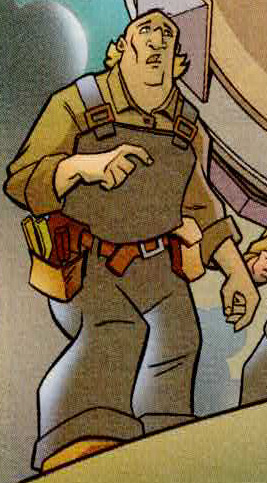
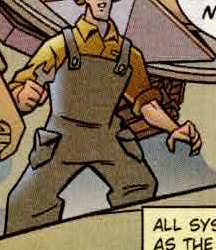
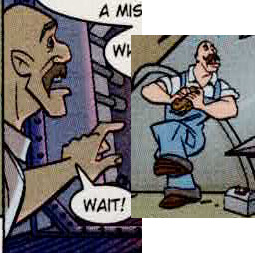
Mechanics 1 and 2 are wearing yellow shirts and grey overalls, which might be the garage uniform. I don't recall if we see any of these uniforms in the film. 3 (the only one with dialogue) is dressed in a white shirt and blue overalls which matches the ones we see in when the Ulysses starts flooding, which may mean it's the engine room's uniform. I couldn't see his glorious mustache during that sequence, though.
#2001#July 2001#Disney Adventures#Buena Vista Magazines Inc.#story#comic#Ulysses#Digger#Gaetan “Mole” Molière#Audrey Rocio Ramirez#mechanics#Wilhelmina Bertha Packard#Lyle Tiberius Rourke#Helga Katrina Sinclair#media#Atlantis: The Lost Empire
20 notes
·
View notes
Text


Jon Moss and the 510SS at ImpalaFest 2000.
Engine: 508.7 cu.-in. (8.4-liter) cast-iron OHV marine V8 Horsepower: 546 @ 5500 RPM Torque: 610 ft.-lb. @ 4000 RPM Bore: 4.5 in. (114.3mm) Stroke: 4.0 in. (101.6mm) Compression Ratio: 9.6:1 GM-SPO modified W-port aluminum cylinder heads Manley 2.25-in. stainless steel intake valves Manley 1.88-in. stainless steel exhaust valves Crane valve springs, stem seals, retainers and keepers Crane aluminum roller rocker arms and studs Crane hydraulic roller camshaft, intake: 226° duration, .587-in. lift, exhaust: 234° duration, .610-in. lift Speed Pro hydraulic roller followers CV Products push rods, Crane guide plates Wiseco forged flattop pistons Wiseco piston rings, top: 1/16 in. moly, middle: 1/16-in. cast, oil: 3/16-in. chrome faced Speed Pro roller timing set Arizona Speed & Marine dual 58mm throttle bores K&N dual air filter assembly AC Rochester 4.8 grams-per-second port fuel injectors SX Performance 80 gal.-per-hour frame-mounted fuel pump and high-flow filter SX Performance 43.5-psi fuel pressure regulator Wheel To Wheel stainless steel 4-into-1 2-in. tubular headers, 3-in. collectors and exhaust pipes Walker dual Super Turbo mufflers Transmission: GM Powertrain/Hydra-matic Motorsports heavy-duty 4-speed automatic, diesel-application transmission control module, gear ratios: FIRST 2.482 SECOND 1.482 THIRD 1.0 FOURTH 0.750:1 Drive: Dana 60 center housing with fabricated axle tubes, Dyno-Tech 3.5-in.-dia. x .83-in. wall steel tube driveshaft, Dana-Spicer 1350 Series U-joints, 4.10:1 Dana Torque-Lok limited-slip differential, Strange Engineering axle shafts Wheelbase: 115.9 in. Track, f/r: 62.3/62.7 in. Weight: 4424 pounds Suspension, front: A-arms, coil springs (lowered 2 in.), Bilstein adjustable shock absorbers, 32mm hollow stabilizer bar Suspension, rear: Solid axle, coil springs (lowered 2.5 in.), Bilstein adjustable shock absorbers, 4 trailing links, 29mm hollow stabilizer bar, torque arm boxed with .083-in. steel plate Brakes: 4-wheel discs with ABS, Brembo 6-piston front calipers, Wilwood adjustable proportioning valve Wheels: Boyd's, f: 17 x 9.5 in., r: 17 x 13 in. Tires: Michelin XGT-Z, f: 275/40ZR17, r: 335/35ZR17
6 notes
·
View notes